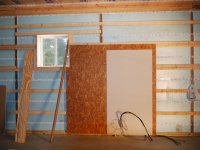If you do go with Drywall, I'd consider 5/8 everywhere.
the 1/2 lightwieght board is pretty soft. 5/8 will be more impact resistant.
And on the chance you do need to use a wall anchor it will hold up better.
The 5/8b is rated for longer exposure to fire.
I dont mind a plywood wall. Painted OSB would almost be acceptable, though I am not a fan of the product.
the current price of ply in my area would steer me to drywall.
the 1/2 lightwieght board is pretty soft. 5/8 will be more impact resistant.
And on the chance you do need to use a wall anchor it will hold up better.
The 5/8b is rated for longer exposure to fire.
I dont mind a plywood wall. Painted OSB would almost be acceptable, though I am not a fan of the product.
the current price of ply in my area would steer me to drywall.

